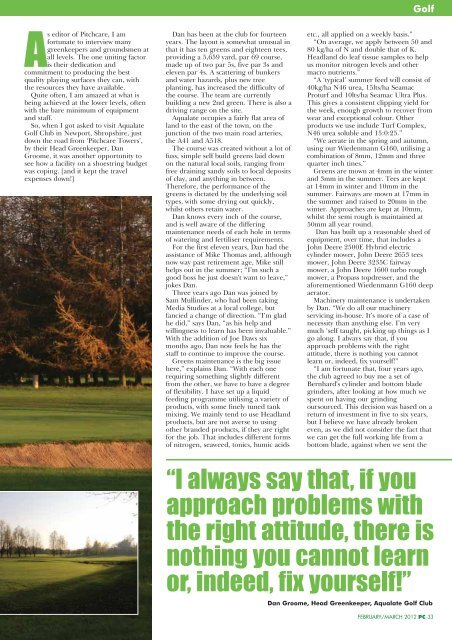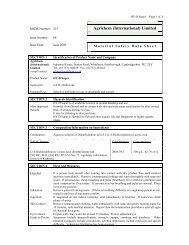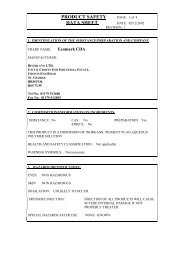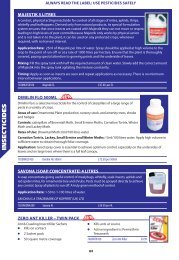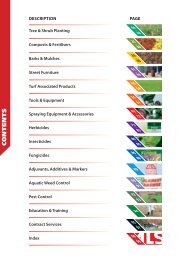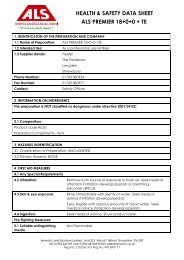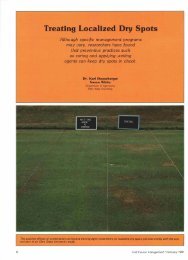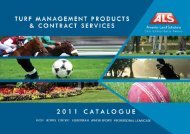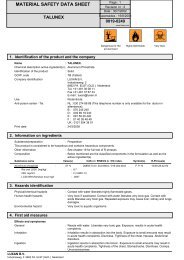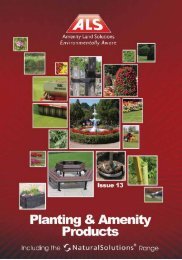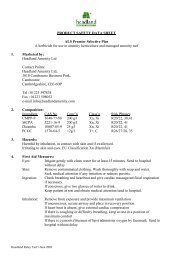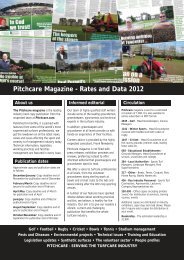these Open Championship Clubs choose to relief grind - Pitchcare
these Open Championship Clubs choose to relief grind - Pitchcare
these Open Championship Clubs choose to relief grind - Pitchcare
Create successful ePaper yourself
Turn your PDF publications into a flip-book with our unique Google optimized e-Paper software.
As edi<strong>to</strong>r of <strong>Pitchcare</strong>, I am<br />
fortunate <strong>to</strong> interview many<br />
greenkeepers and groundsmen at<br />
all levels. The one uniting fac<strong>to</strong>r<br />
is their dedication and<br />
commitment <strong>to</strong> producing the best<br />
quality playing surfaces they can, with<br />
the resources they have available.<br />
Quite often, I am amazed at what is<br />
being achieved at the lower levels, often<br />
with the bare minimum of equipment<br />
and staff.<br />
So, when I got asked <strong>to</strong> visit Aqualate<br />
Golf Club in Newport, Shropshire, just<br />
down the road from ‘<strong>Pitchcare</strong> Towers’,<br />
by their Head Greenkeeper, Dan<br />
Groome, it was another opportunity <strong>to</strong><br />
see how a facility on a shoestring budget<br />
was coping. [and it kept the travel<br />
expenses down!]<br />
Dan has been at the club for fourteen<br />
years. The layout is somewhat unusual in<br />
that it has ten greens and eighteen tees,<br />
providing a 5,659 yard, par 69 course,<br />
made up of two par 5s, five par 3s and<br />
eleven par 4s. A scattering of bunkers<br />
and water hazards, plus new tree<br />
planting, has increased the difficulty of<br />
the course. The team are currently<br />
building a new 2nd green. There is also a<br />
driving range on the site.<br />
Aqualate occupies a fairly flat area of<br />
land <strong>to</strong> the east of the <strong>to</strong>wn, on the<br />
junction of the two main road arteries,<br />
the A41 and A518.<br />
The course was created without a lot of<br />
fuss, simple self build greens laid down<br />
on the natural local soils, ranging from<br />
free draining sandy soils <strong>to</strong> local deposits<br />
of clay, and anything in between.<br />
Therefore, the performance of the<br />
greens is dictated by the underlying soil<br />
types, with some drying out quickly,<br />
whilst others retain water.<br />
Dan knows every inch of the course,<br />
and is well aware of the differing<br />
maintenance needs of each hole in terms<br />
of watering and fertiliser requirements.<br />
For the first eleven years, Dan had the<br />
assistance of Mike Thomas and, although<br />
now way past retirement age, Mike still<br />
helps out in the summer; “I’m such a<br />
good boss he just doesn't want <strong>to</strong> leave,”<br />
jokes Dan.<br />
Three years ago Dan was joined by<br />
Sam Mullinder, who had been taking<br />
Media Studies at a local college, but<br />
fancied a change of direction. “I’m glad<br />
he did,” says Dan, “as his help and<br />
willingness <strong>to</strong> learn has been invaluable.”<br />
With the addition of Joe Daws six<br />
months ago, Dan now feels he has the<br />
staff <strong>to</strong> continue <strong>to</strong> improve the course.<br />
Greens maintenance is the big issue<br />
here,” explains Dan. “With each one<br />
requiring something slightly different<br />
from the other, we have <strong>to</strong> have a degree<br />
of flexibility. I have set up a liquid<br />
feeding programme utilising a variety of<br />
products, with some finely tuned tank<br />
mixing. We mainly tend <strong>to</strong> use Headland<br />
products, but are not averse <strong>to</strong> using<br />
other branded products, if they are right<br />
for the job. That includes different forms<br />
of nitrogen, seaweed, <strong>to</strong>nics, humic acids<br />
Golf<br />
etc., all applied on a weekly basis.”<br />
“On average, we apply between 50 and<br />
80 kg/ha of N and double that of K.<br />
Headland do leaf tissue samples <strong>to</strong> help<br />
us moni<strong>to</strong>r nitrogen levels and other<br />
macro nutrients.”<br />
“A ‘typical’ summer feed will consist of<br />
40kg/ha N46 urea, 15lts/ha Seamac<br />
Proturf and 10lts/ha Seamac Ultra Plus.<br />
This gives a consistent clipping yield for<br />
the week, enough growth <strong>to</strong> recover from<br />
wear and exceptional colour. Other<br />
products we use include Turf Complex,<br />
N46 urea soluble and 15:0:25.”<br />
“We aerate in the spring and autumn,<br />
using our Wiedenmann G160, utilising a<br />
combination of 8mm, 12mm and three<br />
quarter inch tines.”<br />
Greens are mown at 4mm in the winter<br />
and 3mm in the summer. Tees are kept<br />
at 14mm in winter and 10mm in the<br />
summer. Fairways are mown at 17mm in<br />
the summer and raised <strong>to</strong> 20mm in the<br />
winter. Approaches are kept at 10mm,<br />
whilst the semi rough is maintained at<br />
50mm all year round.<br />
Dan has built up a reasonable shed of<br />
equipment, over time, that includes a<br />
John Deere 2500E Hybrid electric<br />
cylinder mower, John Deere 2653 tees<br />
mower, John Deere 3235C fairway<br />
mower, a John Deere 1600 turbo rough<br />
mower, a Propass <strong>to</strong>pdresser, and the<br />
aforementioned Wiedenmann G160 deep<br />
aera<strong>to</strong>r.<br />
Machinery maintenance is undertaken<br />
by Dan. “We do all our machinery<br />
servicing in-house. It’s more of a case of<br />
necessity than anything else. I’m very<br />
much ‘self taught, picking up things as I<br />
go along. I always say that, if you<br />
approach problems with the right<br />
attitude, there is nothing you cannot<br />
learn or, indeed, fix yourself!”<br />
“I am fortunate that, four years ago,<br />
the club agreed <strong>to</strong> buy me a set of<br />
Bernhard's cylinder and bot<strong>to</strong>m blade<br />
<strong>grind</strong>ers, after looking at how much we<br />
spent on having our <strong>grind</strong>ing<br />
oursourced. This decision was based on a<br />
return of investment in five <strong>to</strong> six years,<br />
but I believe we have already broken<br />
even, as we did not consider the fact that<br />
we can get the full working life from a<br />
bot<strong>to</strong>m blade, against when we sent the<br />
“I always say that, if you<br />
approach problems with<br />
the right attitude, there is<br />
nothing you cannot learn<br />
or, indeed, fix yourself!”<br />
Dan Groome, Head Greenkeeper, Aqualate Golf Club<br />
FEBRUARY/MARCH 2012 PC 33


